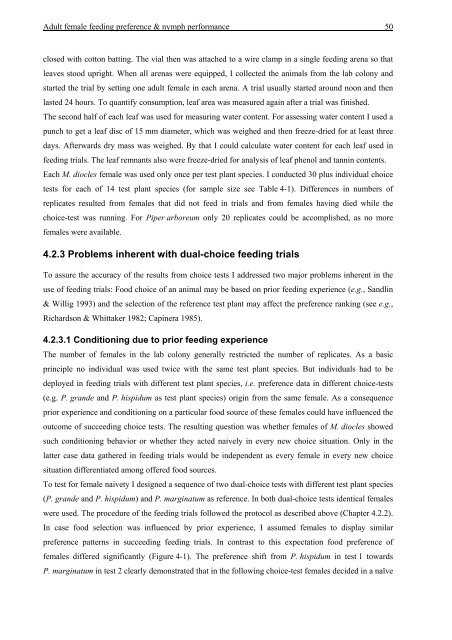ecology of phasmids - KLUEDO - Universität Kaiserslautern
ecology of phasmids - KLUEDO - Universität Kaiserslautern
ecology of phasmids - KLUEDO - Universität Kaiserslautern
Create successful ePaper yourself
Turn your PDF publications into a flip-book with our unique Google optimized e-Paper software.
Adult female feeding preference & nymph performance 50<br />
closed with cotton batting. The vial then was attached to a wire clamp in a single feeding arena so that<br />
leaves stood upright. When all arenas were equipped, I collected the animals from the lab colony and<br />
started the trial by setting one adult female in each arena. A trial usually started around noon and then<br />
lasted 24 hours. To quantify consumption, leaf area was measured again after a trial was finished.<br />
The second half <strong>of</strong> each leaf was used for measuring water content. For assessing water content I used a<br />
punch to get a leaf disc <strong>of</strong> 15 mm diameter, which was weighed and then freeze-dried for at least three<br />
days. Afterwards dry mass was weighed. By that I could calculate water content for each leaf used in<br />
feeding trials. The leaf remnants also were freeze-dried for analysis <strong>of</strong> leaf phenol and tannin contents.<br />
Each M. diocles female was used only once per test plant species. I conducted 30 plus individual choice<br />
tests for each <strong>of</strong> 14 test plant species (for sample size see Table 4-1). Differences in numbers <strong>of</strong><br />
replicates resulted from females that did not feed in trials and from females having died while the<br />
choice-test was running. For Piper arboreum only 20 replicates could be accomplished, as no more<br />
females were available.<br />
4.2.3 Problems inherent with dual-choice feeding trials<br />
To assure the accuracy <strong>of</strong> the results from choice tests I addressed two major problems inherent in the<br />
use <strong>of</strong> feeding trials: Food choice <strong>of</strong> an animal may be based on prior feeding experience (e.g., Sandlin<br />
& Willig 1993) and the selection <strong>of</strong> the reference test plant may affect the preference ranking (see e.g.,<br />
Richardson & Whittaker 1982; Capinera 1985).<br />
4.2.3.1 Conditioning due to prior feeding experience<br />
The number <strong>of</strong> females in the lab colony generally restricted the number <strong>of</strong> replicates. As a basic<br />
principle no individual was used twice with the same test plant species. But individuals had to be<br />
deployed in feeding trials with different test plant species, i.e. preference data in different choice-tests<br />
(e.g. P. grande and P. hispidum as test plant species) origin from the same female. As a consequence<br />
prior experience and conditioning on a particular food source <strong>of</strong> these females could have influenced the<br />
outcome <strong>of</strong> succeeding choice tests. The resulting question was whether females <strong>of</strong> M. diocles showed<br />
such conditioning behavior or whether they acted naively in every new choice situation. Only in the<br />
latter case data gathered in feeding trials would be independent as every female in every new choice<br />
situation differentiated among <strong>of</strong>fered food sources.<br />
To test for female naivety I designed a sequence <strong>of</strong> two dual-choice tests with different test plant species<br />
(P. grande and P. hispidum) and P. marginatum as reference. In both dual-choice tests identical females<br />
were used. The procedure <strong>of</strong> the feeding trials followed the protocol as described above (Chapter 4.2.2).<br />
In case food selection was influenced by prior experience, I assumed females to display similar<br />
preference patterns in succeeding feeding trials. In contrast to this expectation food preference <strong>of</strong><br />
females differed significantly (Figure 4-1). The preference shift from P. hispidum in test 1 towards<br />
P. marginatum in test 2 clearly demonstrated that in the following choice-test females decided in a naïve

















